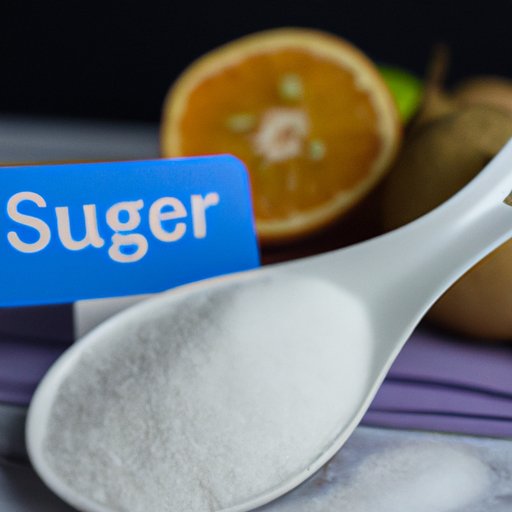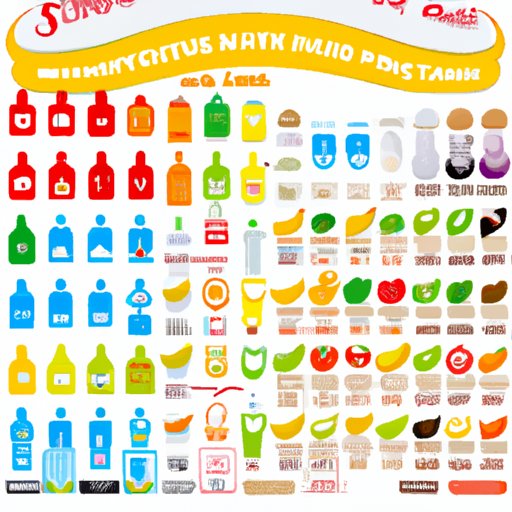Introduction
Excess sugar consumption is a major health concern. According to the World Health Organization (WHO), adults should consume no more than 25 grams of added sugar per day, yet many people are consuming far more than this recommendation. High sugar intake has been linked to obesity, diabetes, heart disease, and other health problems. Therefore, reducing the amount of added sugar in your diet is essential for maintaining good health. In this article, we’ll discuss how to cut sugar out of your diet by avoiding processed and pre-packaged foods, reading nutrition labels and ingredient lists, choosing unsweetened beverages, eating more whole fruits and vegetables, replacing sugar with natural sweeteners, reducing portion sizes of sugary snacks, and limiting sugar-rich condiments and sauces.
Avoid Processed and Pre-Packaged Foods
Processed and pre-packaged foods are often loaded with added sugars and other unhealthy ingredients. A study published in the Journal of the American Medical Association found that 60% of calories consumed by Americans come from ultra-processed foods. These foods can be convenient, but they are often high in calories and low in nutritional value. Additionally, they contain artificial flavors, preservatives, and other additives that can be harmful to your health. Therefore, it’s important to avoid these types of foods as much as possible.
Reasons to Avoid Processed and Pre-Packaged Foods
Processed and pre-packaged foods are typically high in calories, fat, sodium, and added sugars. They often contain little to no fiber or protein, which can leave you feeling hungry soon after eating. Additionally, these foods are often highly processed, meaning they have been altered from their original state. This processing can strip away important nutrients and add unhealthy ingredients such as artificial colors and flavors. Therefore, it’s best to avoid processed and pre-packaged foods as much as possible.
Tips for Identifying Processed and Pre-Packaged Foods
When shopping for food, it’s important to read labels carefully. Look for words such as “hydrogenated” or “partially hydrogenated” on the label, as these indicate the presence of trans fats, which are unhealthy. Additionally, look for high levels of sodium, sugar, and saturated fat on the nutrition label. If any of these ingredients are listed near the top of the list, it’s best to avoid the product. Additionally, it’s important to check the ingredients list for added sugars, which may be listed as “corn syrup,” “high fructose corn syrup,” “dextrose,” “maltose,” “fructose,” or “fruit juice concentrate.” If any of these ingredients are present, it’s best to choose a different product.

Read Nutrition Labels and Ingredient Lists
Reading nutrition labels and ingredient lists is an important part of cutting sugar out of your diet. Nutrition labels provide information about the calories, fat, sodium, and other nutrients in a product. Ingredient lists provide information about what is actually in the product. By reading both labels closely, you can identify products that are high in added sugars and other unhealthy ingredients.
Understanding Ingredients on Labels
The ingredients list on a food label will tell you what is in the product. It is important to note that ingredients are listed in order of quantity – the ingredient at the top of the list is the most abundant, followed by the next most abundant, and so on. Sugars can be listed under various names, including “sugar,” “brown sugar,” “honey,” “corn syrup,” “high fructose corn syrup,” “dextrose,” “maltose,” “fructose,” and “fruit juice concentrate.” If any of these ingredients are listed near the top of the list, it’s best to avoid the product.
Tips for Reading Labels and Ingredient Lists
When reading labels and ingredient lists, it’s important to pay attention to serving size. The nutrition facts and ingredients listed are for one serving, not the entire package. Additionally, it’s important to look for products that are low in calories, fat, sodium, and sugar. Aim for products with no more than 5-10 grams of sugar per serving. Finally, it’s important to look for products that are high in fiber and protein, as these will help keep you full and satisfied.
Choose Unsweetened Beverages
Sugary drinks are a major source of added sugar in the diet. Sodas, sports drinks, energy drinks, and sweetened teas are all high in sugar and offer little to no nutritional value. Therefore, it’s important to choose unsweetened beverages instead.
Benefits of Unsweetened Beverages
Unsweetened beverages are much healthier than sugary drinks. They are usually lower in calories and free of added sugars. Additionally, some unsweetened beverages, such as green tea, may even offer health benefits. A study published in the journal Nutrients found that green tea may help reduce inflammation and improve cardiovascular health. Therefore, it’s important to choose unsweetened beverages whenever possible.
Tips for Choosing Unsweetened Beverages
When choosing beverages, it’s important to read labels carefully. Many juices, teas, and other beverages may appear to be unsweetened, but they may still contain added sugars. Additionally, be sure to check the ingredient list for added sugars, which may be listed as “corn syrup,” “high fructose corn syrup,” “dextrose,” “maltose,” “fructose,” or “fruit juice concentrate.” If any of these ingredients are present, it’s best to choose a different beverage. Additionally, try to opt for water whenever possible. Water is calorie-free and contains no added sugars or other unhealthy ingredients.

Eat More Whole Fruits and Vegetables
Fruits and vegetables are an important part of a healthy diet. They are packed with vitamins, minerals, and other important nutrients. Additionally, they are naturally low in calories and free of added sugars. Therefore, it’s important to incorporate more whole fruits and vegetables into your diet.
Benefits of Eating More Whole Fruits and Vegetables
Eating more whole fruits and vegetables can help you reduce your sugar intake and get the nutrients your body needs. Fruits and vegetables are naturally low in calories and contain no added sugars. Additionally, they are a good source of fiber, which can help keep you full and satisfied. A study published in the journal Public Health Nutrition found that increasing fruit and vegetable intake was associated with a decreased risk of obesity. Therefore, it’s important to incorporate more whole fruits and vegetables into your diet.
Tips for Incorporating More Whole Fruits and Vegetables into Your Diet
When incorporating more fruits and vegetables into your diet, it’s important to choose fresh, frozen, or canned varieties. Avoid processed or pre-packaged varieties, as these often contain added sugars or other unhealthy ingredients. Additionally, aim to eat a variety of different fruits and vegetables to ensure you’re getting a wide range of vitamins, minerals, and other nutrients. Finally, try to eat whole fruits and vegetables rather than juices or smoothies, as these can be high in added sugars.

Replace Sugar with Natural Sweeteners
While it’s important to limit sugar consumption, it’s also important to satisfy your sweet tooth. Luckily, there are many natural sweeteners that can be used to replace sugar in recipes. Natural sweeteners are typically lower in calories than sugar and may even offer health benefits. Therefore, it’s important to explore natural sweetener options.
Types of Natural Sweeteners
There are many types of natural sweeteners available. Some popular options include honey, maple syrup, coconut sugar, stevia, and monk fruit. These sweeteners may offer health benefits due to their higher levels of antioxidants and other nutrients. Additionally, they are often lower in calories than sugar and can be used to sweeten recipes without adding too many extra calories.
Tips for Replacing Sugar with Natural Sweeteners
When replacing sugar with natural sweeteners, it’s important to start with small amounts. Natural sweeteners can be stronger than sugar, so it’s best to start with a small amount and adjust as needed. Additionally, it’s important to read labels carefully when purchasing natural sweeteners. Some brands may add unhealthy ingredients such as corn syrup or artificial flavors. Therefore, it’s best to choose natural, unprocessed sweeteners whenever possible.
Reduce Portion Sizes of Sugary Snacks
Sugary snacks such as cookies, cakes, and candy are often high in added sugars and calories. Therefore, it’s important to limit your intake of these types of snacks. Additionally, it’s important to be mindful of portion sizes when eating sugary snacks. Even if you’re only eating a few bites, it’s important to be aware of how much sugar you’re consuming.
Benefits of Reducing Portion Sizes of Sugary Snacks
Reducing the portion size of sugary snacks can help you limit your sugar intake and prevent weight gain. A study published in the journal Appetite found that smaller portion sizes were associated with lower caloric intake and improved weight management. Therefore, it’s important to be mindful of portion sizes when eating sugary snacks.
Tips for Reducing Portion Sizes of Sugary Snacks
When eating sugary snacks, it’s important to practice portion control. Try to limit yourself to one or two bites of a sugary snack. Additionally, it’s important to read labels carefully. Some snacks may appear to be low in sugar, but they may still contain added sugars. Finally, it’s important to remember that sugary snacks should not be a regular part of your diet. Instead, focus on eating whole, nutritious foods most of the time.
Limit Sugar-Rich Condiments and Sauces
Condiments and sauces can be a hidden source of added sugar in the diet. Many store-bought sauces and dressings contain added sugars, as do some condiments such as ketchup and barbecue sauce. Therefore, it’s important to read labels carefully and opt for unsweetened varieties whenever possible.
Benefits of Limiting Sugar-Rich Condiments and Sauces
Limiting sugar-rich condiments and sauces can help you reduce your sugar intake and maintain a healthy weight. A study published in the British Medical Journal found that limiting added sugars was associated with reduced body weight and waist circumference. Therefore, it’s important to limit your intake of sugar-rich condiments and sauces.
Tips for Limiting Sugar-Rich Condiments and Sauces
When choosing condiments and sauces, it’s important to read labels carefully. Look for products that are low in added sugars and high in protein and fiber. Additionally, it’s important to be mindful of portion sizes. Even if you’re using a low-sugar condiment or sauce, it’s important to use it sparingly. Finally, try to opt for homemade condiments and sauces whenever possible. Homemade versions are often lower in added sugars and higher in nutrients.
Conclusion
Reducing sugar intake is an important part of maintaining good health. By avoiding processed and pre-packaged foods, reading nutrition labels and ingredient lists, choosing unsweetened beverages, eating more whole fruits and vegetables, replacing sugar with natural sweeteners, reducing portion sizes of sugary snacks, and limiting sugar-rich condiments and sauces, you can easily cut down on your sugar intake and make healthier choices.
(Note: Is this article not meeting your expectations? Do you have knowledge or insights to share? Unlock new opportunities and expand your reach by joining our authors team. Click Registration to join us and share your expertise with our readers.)
